Page 300 of 558
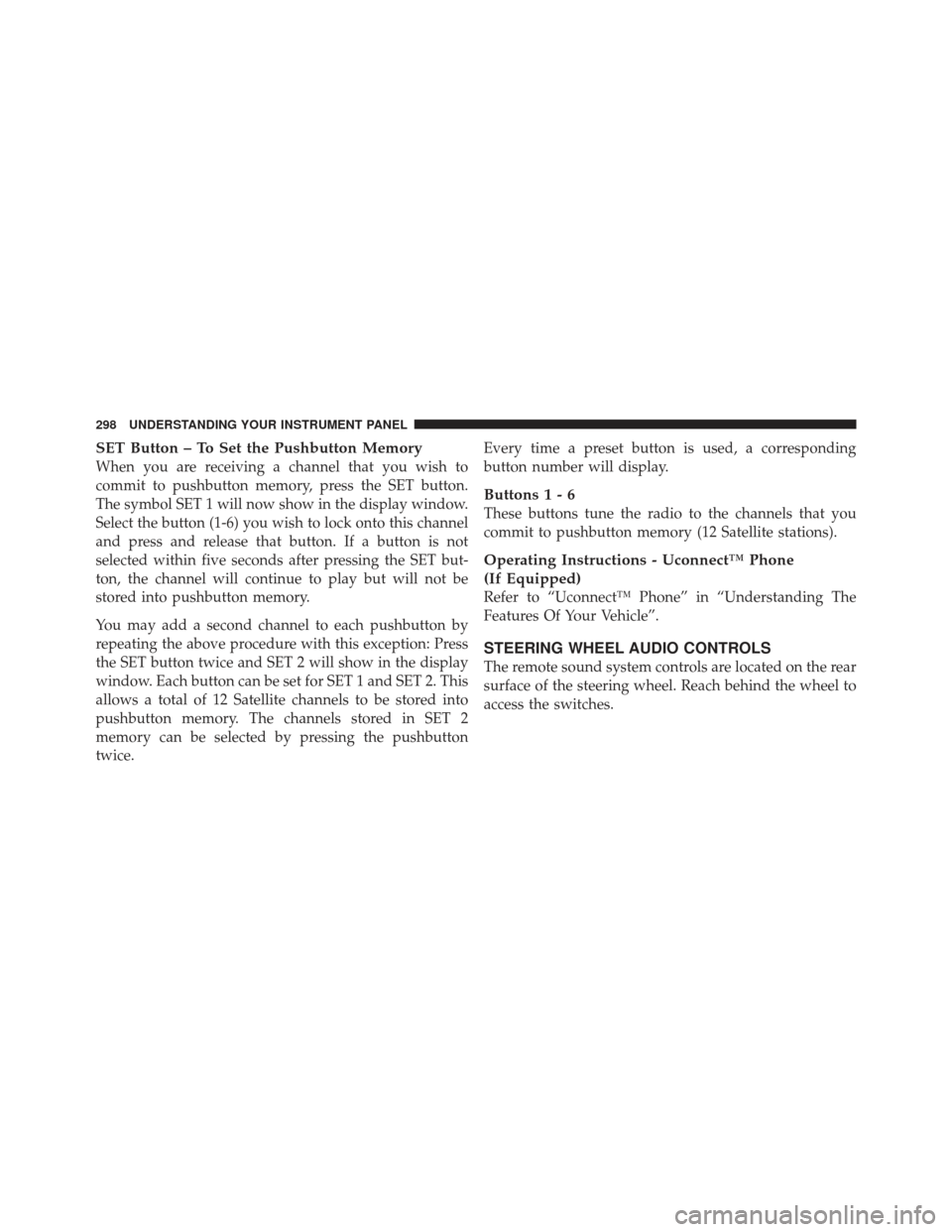
SET Button – To Set the Pushbutton Memory
When you are receiving a channel that you wish to
commit to pushbutton memory, press the SET button.
The symbol SET 1 will now show in the display window.
Select the button (1-6) you wish to lock onto this channel
and press and release that button. If a button is not
selected within five seconds after pressing the SET but-
ton, the channel will continue to play but will not be
stored into pushbutton memory.
You may add a second channel to each pushbutton by
repeating the above procedure with this exception: Press
the SET button twice and SET 2 will show in the display
window. Each button can be set for SET 1 and SET 2. This
allows a total of 12 Satellite channels to be stored into
pushbutton memory. The channels stored in SET 2
memory can be selected by pressing the pushbutton
twice.Every time a preset button is used, a corresponding
button number will display.
Buttons1-6
These buttons tune the radio to the channels that you
commit to pushbutton memory (12 Satellite stations).
Operating Instructions - Uconnect™ Phone
(If Equipped)
Refer to “Uconnect™ Phone” in “Understanding The
Features Of Your Vehicle”.
STEERING WHEEL AUDIO CONTROLS
The remote sound system controls are located on the rear
surface of the steering wheel. Reach behind the wheel to
access the switches.
298 UNDERSTANDING YOUR INSTRUMENT PANEL
Page 301 of 558
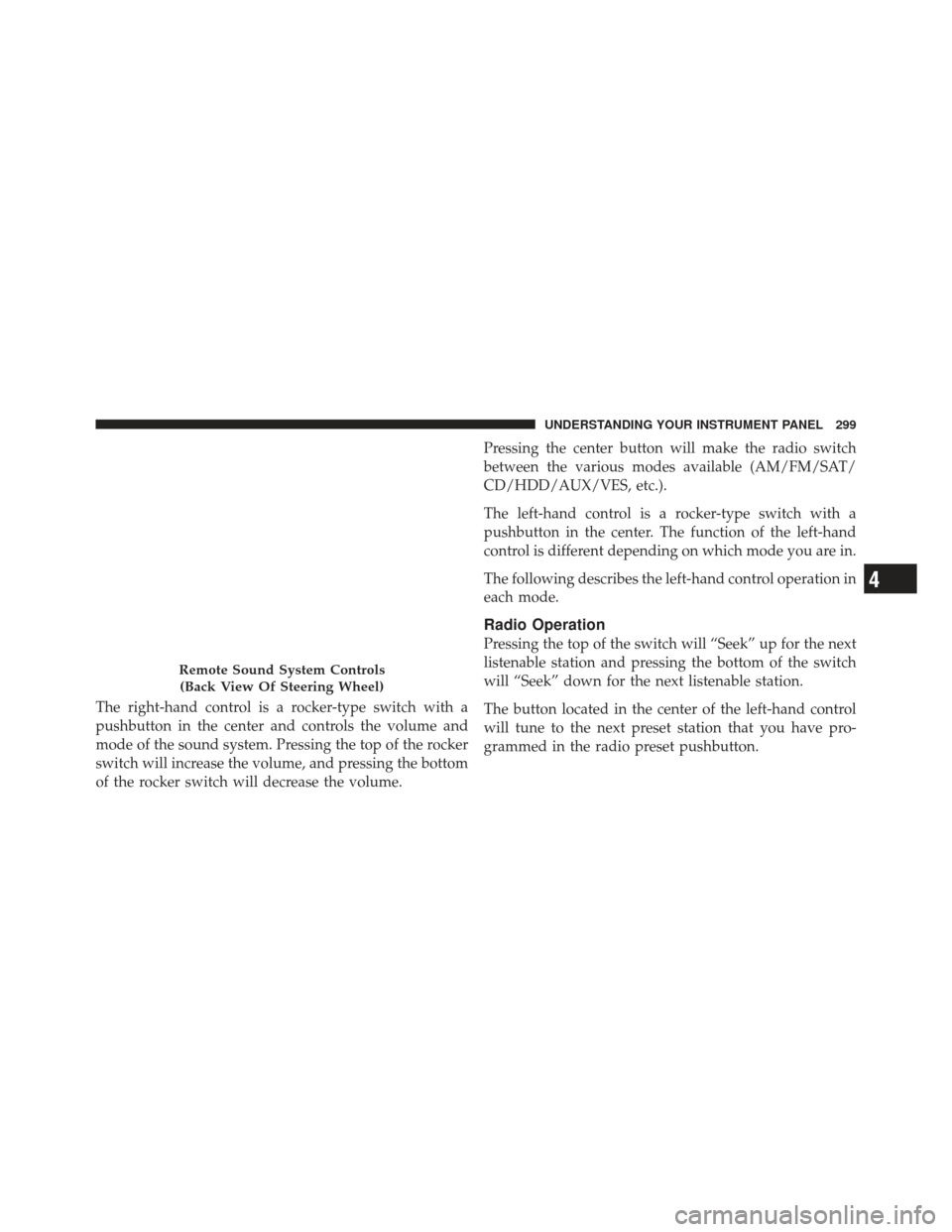
The right-hand control is a rocker-type switch with a
pushbutton in the center and controls the volume and
mode of the sound system. Pressing the top of the rocker
switch will increase the volume, and pressing the bottom
of the rocker switch will decrease the volume.Pressing the center button will make the radio switch
between the various modes available (AM/FM/SAT/
CD/HDD/AUX/VES, etc.).
The left-hand control is a rocker-type switch with a
pushbutton in the center. The function of the left-hand
control is different depending on which mode you are in.
The following describes the left-hand control operation in
each mode.
Radio Operation
Pressing the top of the switch will “Seek” up for the next
listenable station and pressing the bottom of the switch
will “Seek” down for the next listenable station.
The button located in the center of the left-hand control
will tune to the next preset station that you have pro-
grammed in the radio preset pushbutton.
Remote Sound System Controls
(Back View Of Steering Wheel)
4
UNDERSTANDING YOUR INSTRUMENT PANEL 299
Page 317 of 558
STARTING AND OPERATING
CONTENTS
�Starting Procedures .................... 319
▫ Normal Starting ..................... 319
▫ Extreme Cold Weather
(Below –20°F Or –29°C) ................ 320
▫ If Engine Fails To Start ................ 320
▫ After Starting ....................... 321
� Engine Block Heater — If Equipped ........ 321
� Automatic Transmission ................. 322
▫ Key Ignition Park Interlock ............. 323▫
Brake/Transmission Shift Interlock System . . 323
▫ Four–Speed Automatic Transmission ....... 324
▫ Gear Ranges ........................ 324
� Four-Wheel Drive Operation ............. 333
▫ Command-Trac II� Transfer Case – If
Equipped .......................... 333
▫ Selec-Trac� II Transfer Case – If Equipped . . . 339
� On-Road Driving Tips .................. 344
5
Page 319 of 558
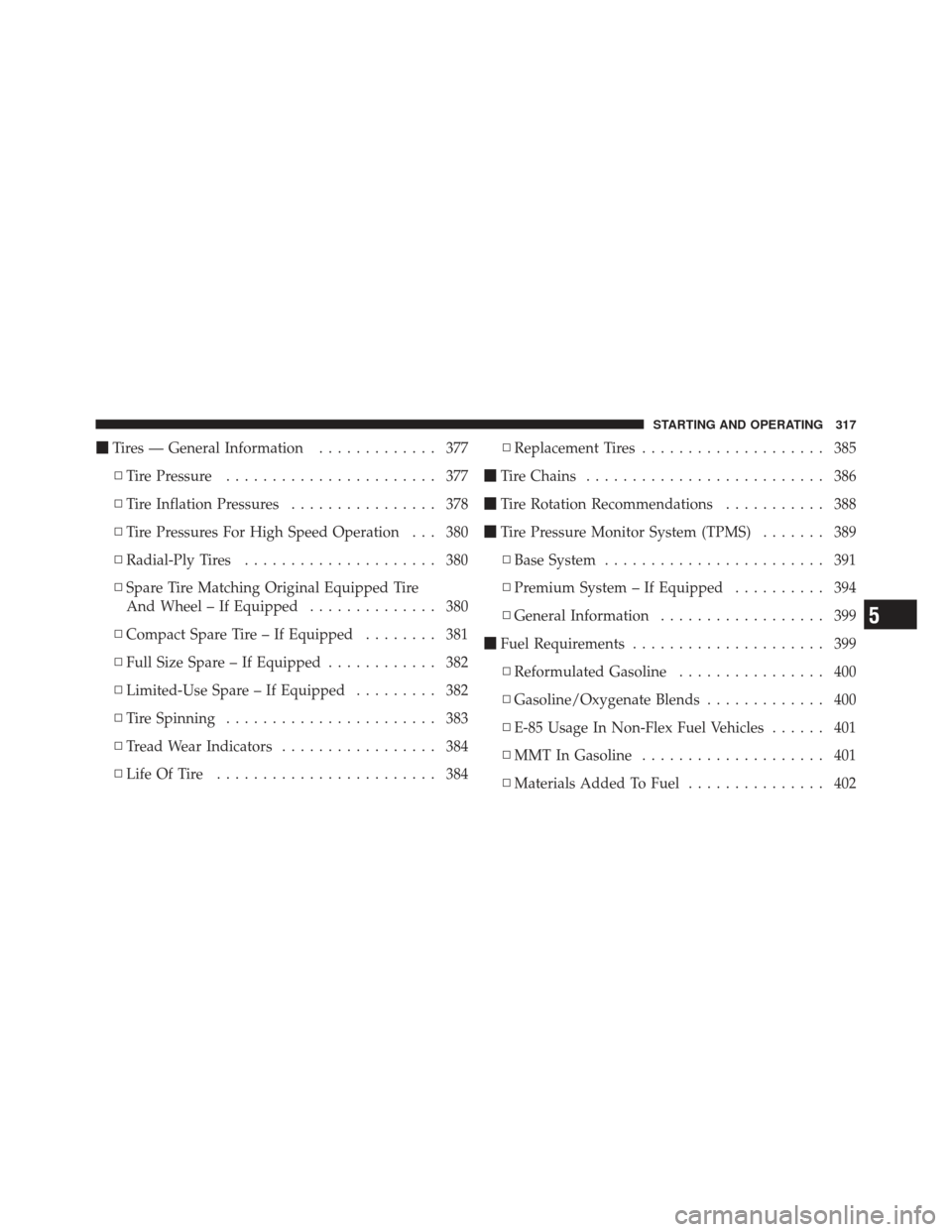
�Tires — General Information ............. 377
▫ Tire Pressure ....................... 377
▫ Tire Inflation Pressures ................ 378
▫ Tire Pressures For High Speed Operation . . . 380
▫ Radial-Ply Tires ..................... 380
▫ Spare Tire Matching Original Equipped Tire
And Wheel – If Equipped .............. 380
▫ Compact Spare Tire – If Equipped ........ 381
▫ Full Size Spare – If Equipped ............ 382
▫ Limited-Use Spare – If Equipped ......... 382
▫ Tire Spinning ....................... 383
▫ Tread Wear Indicators ................. 384
▫ Life Of Tire ........................ 384 ▫
Replacement Tires .................... 385
� Tire Chains .......................... 386
� Tire Rotation Recommendations ........... 388
� Tire Pressure Monitor System (TPMS) ....... 389
▫ Base System ........................ 391
▫ Premium System – If Equipped .......... 394
▫ General Information .................. 399
� Fuel Requirements ..................... 399
▫ Reformulated Gasoline ................ 400
▫ Gasoline/Oxygenate Blends ............. 400
▫ E-85 Usage In Non-Flex Fuel Vehicles ...... 401
▫ MMT In Gasoline .................... 401
▫ Materials Added To Fuel ............... 402
5
STARTING AND OPERATING 317
Page 320 of 558
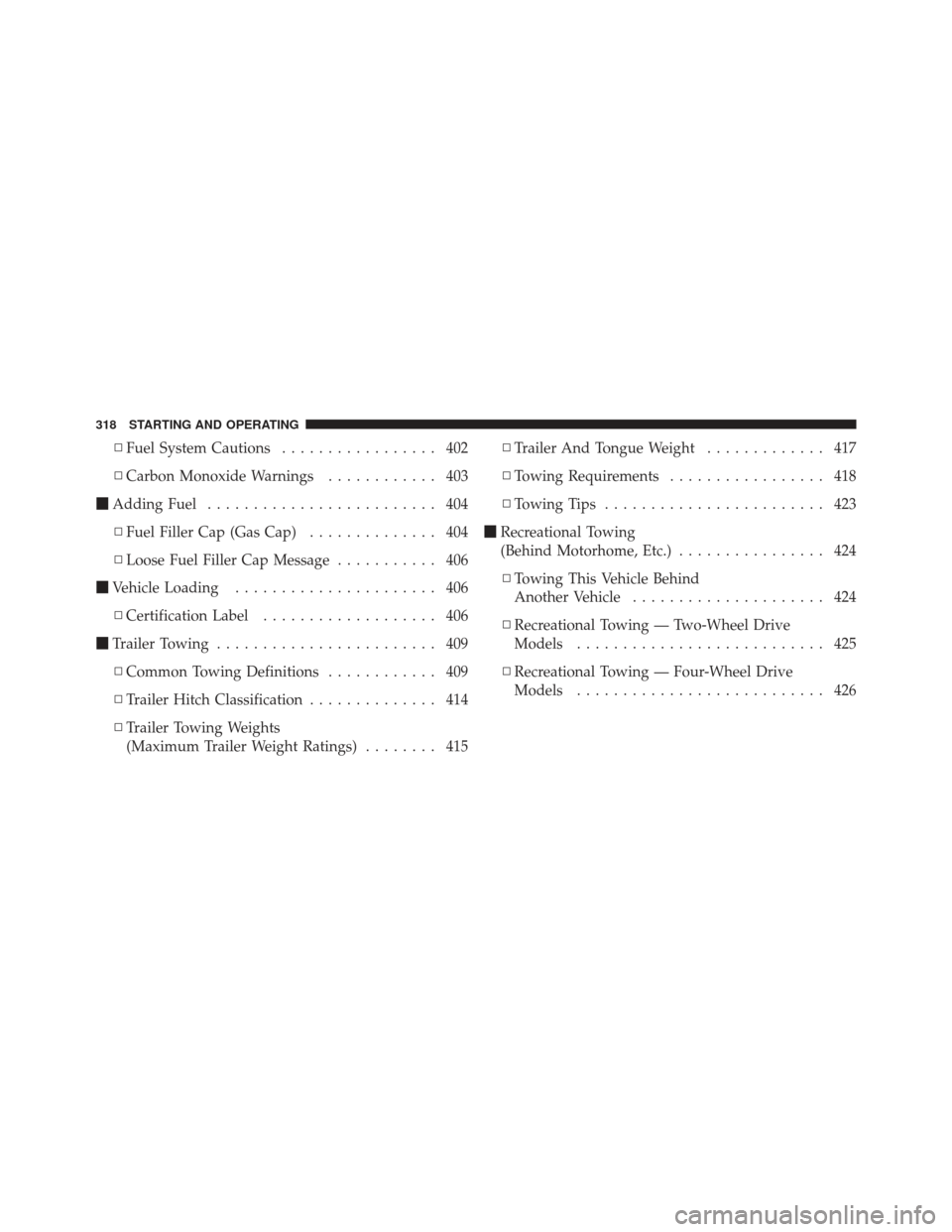
▫Fuel System Cautions ................. 402
▫ Carbon Monoxide Warnings ............ 403
� Adding Fuel ......................... 404
▫ Fuel Filler Cap (Gas Cap) .............. 404
▫ Loose Fuel Filler Cap Message ........... 406
� Vehicle Loading ...................... 406
▫ Certification Label ................... 406
� Trailer Towing ........................ 409
▫ Common Towing Definitions ............ 409
▫ Trailer Hitch Classification .............. 414
▫ Trailer Towing Weights
(Maximum Trailer Weight Ratings) ........ 415▫
Trailer And Tongue Weight ............. 417
▫ Towing Requirements ................. 418
▫ Towing Tips ........................ 423
� Recreational Towing
(Behind Motorhome, Etc.) ................ 424
▫ Towing This Vehicle Behind
Another Vehicle ..................... 424
▫ Recreational Towing — Two-Wheel Drive
Models ........................... 425
▫ Recreational Towing — Four-Wheel Drive
Models ........................... 426
318 STARTING AND OPERATING
Page 327 of 558
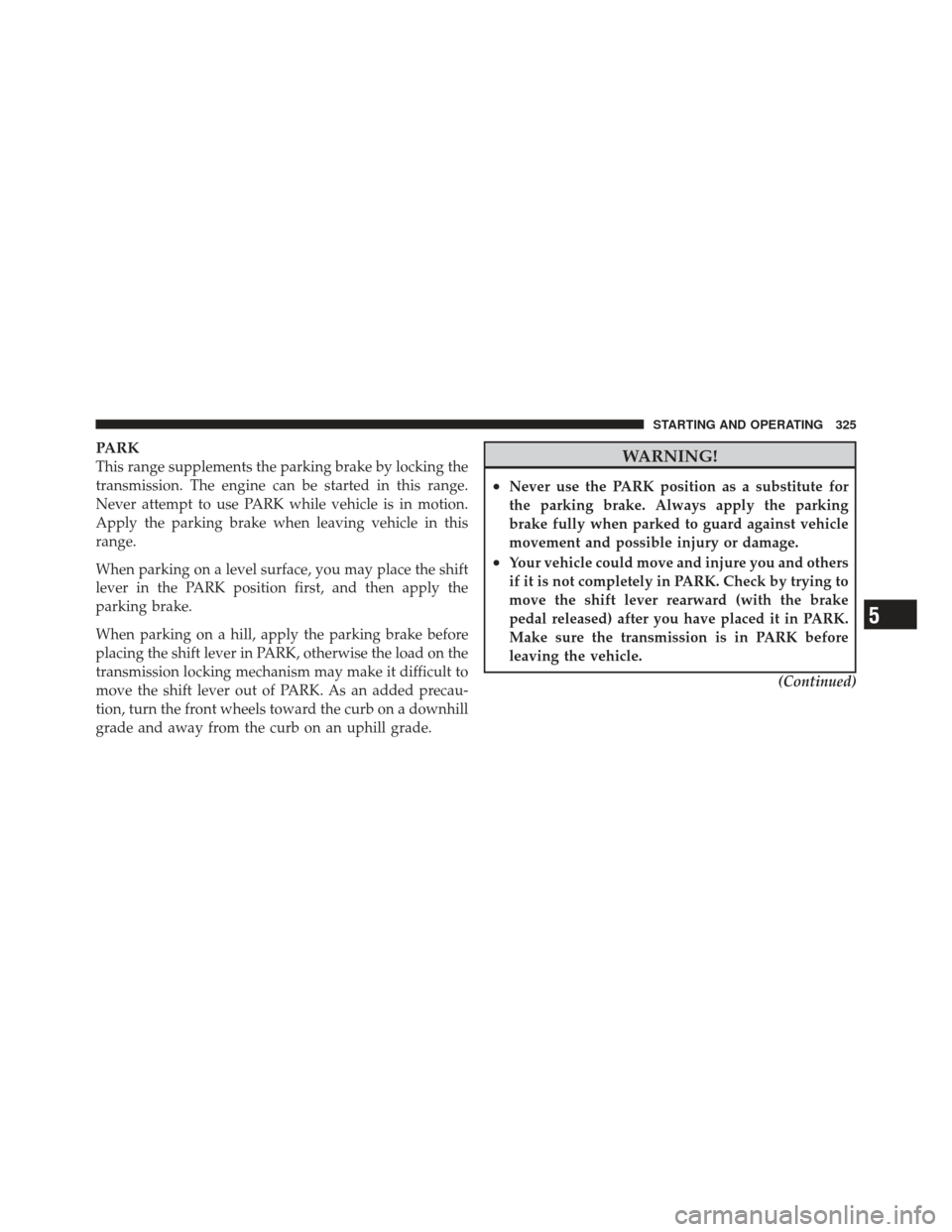
PARK
This range supplements the parking brake by locking the
transmission. The engine can be started in this range.
Never attempt to use PARK while vehicle is in motion.
Apply the parking brake when leaving vehicle in this
range.
When parking on a level surface, you may place the shift
lever in the PARK position first, and then apply the
parking brake.
When parking on a hill, apply the parking brake before
placing the shift lever in PARK, otherwise the load on the
transmission locking mechanism may make it difficult to
move the shift lever out of PARK. As an added precau-
tion, turn the front wheels toward the curb on a downhill
grade and away from the curb on an uphill grade.WARNING!
•Never use the PARK position as a substitute for
the parking brake. Always apply the parking
brake fully when parked to guard against vehicle
movement and possible injury or damage.
•Your vehicle could move and injure you and others
if it is not completely in PARK. Check by trying to
move the shift lever rearward (with the brake
pedal released) after you have placed it in PARK.
Make sure the transmission is in PARK before
leaving the vehicle.(Continued)
5
STARTING AND OPERATING 325
Page 335 of 558
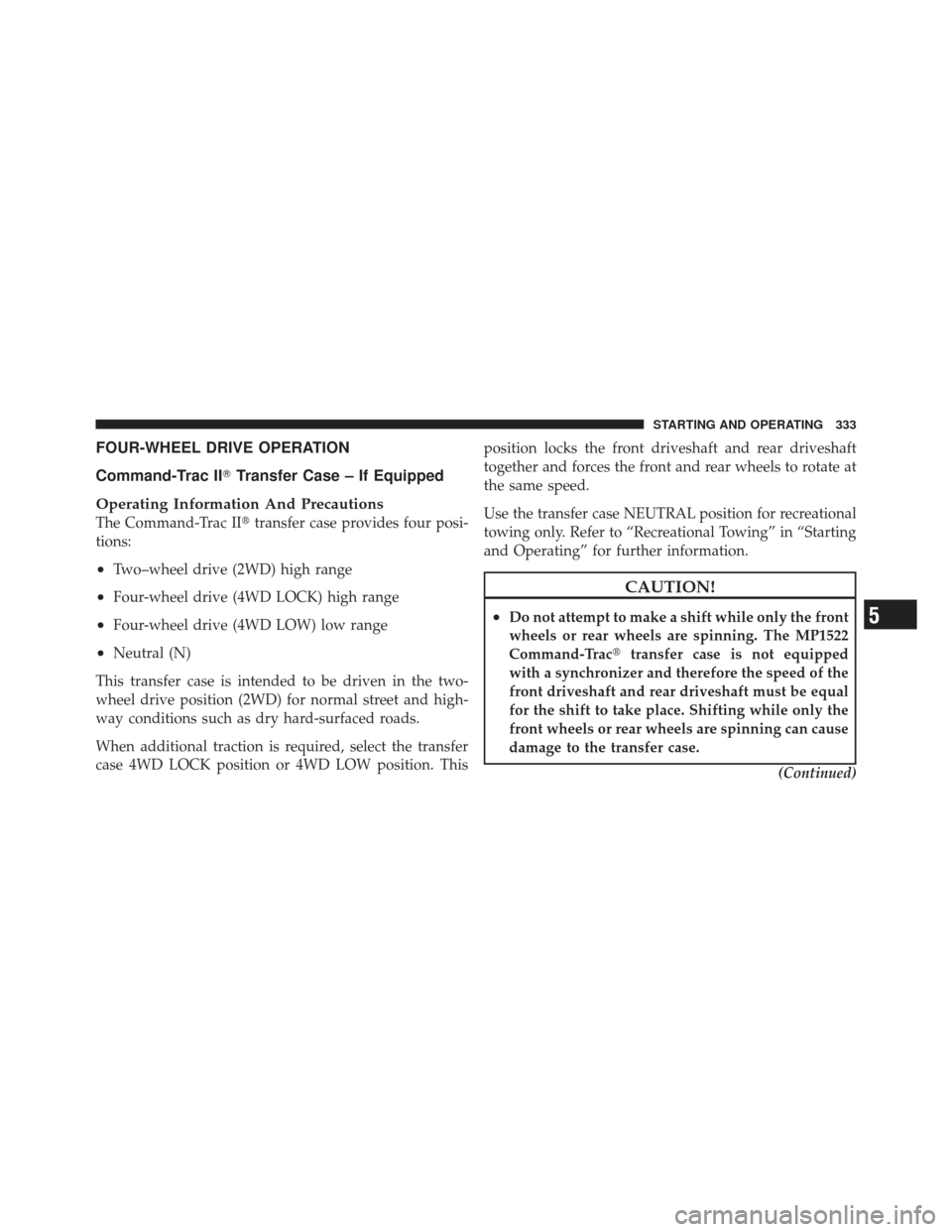
FOUR-WHEEL DRIVE OPERATION
Command-Trac II�Transfer Case – If Equipped
Operating Information And Precautions
The Command-Trac II� transfer case provides four posi-
tions:
•Two–wheel drive (2WD) high range
•Four-wheel drive (4WD LOCK) high range
•Four-wheel drive (4WD LOW) low range
•Neutral (N)
This transfer case is intended to be driven in the two-
wheel drive position (2WD) for normal street and high-
way conditions such as dry hard-surfaced roads.
When additional traction is required, select the transfer
case 4WD LOCK position or 4WD LOW position. This position locks the front driveshaft and rear driveshaft
together and forces the front and rear wheels to rotate at
the same speed.
Use the transfer case NEUTRAL position for recreational
towing only. Refer to “Recreational Towing” in “Starting
and Operating” for further information.
CAUTION!
•Do not attempt to make a shift while only the front
wheels or rear wheels are spinning. The MP1522
Command-Trac�
transfer case is not equipped
with a synchronizer and therefore the speed of the
front driveshaft and rear driveshaft must be equal
for the shift to take place. Shifting while only the
front wheels or rear wheels are spinning can cause
damage to the transfer case.
(Continued)5
STARTING AND OPERATING 333
Page 336 of 558
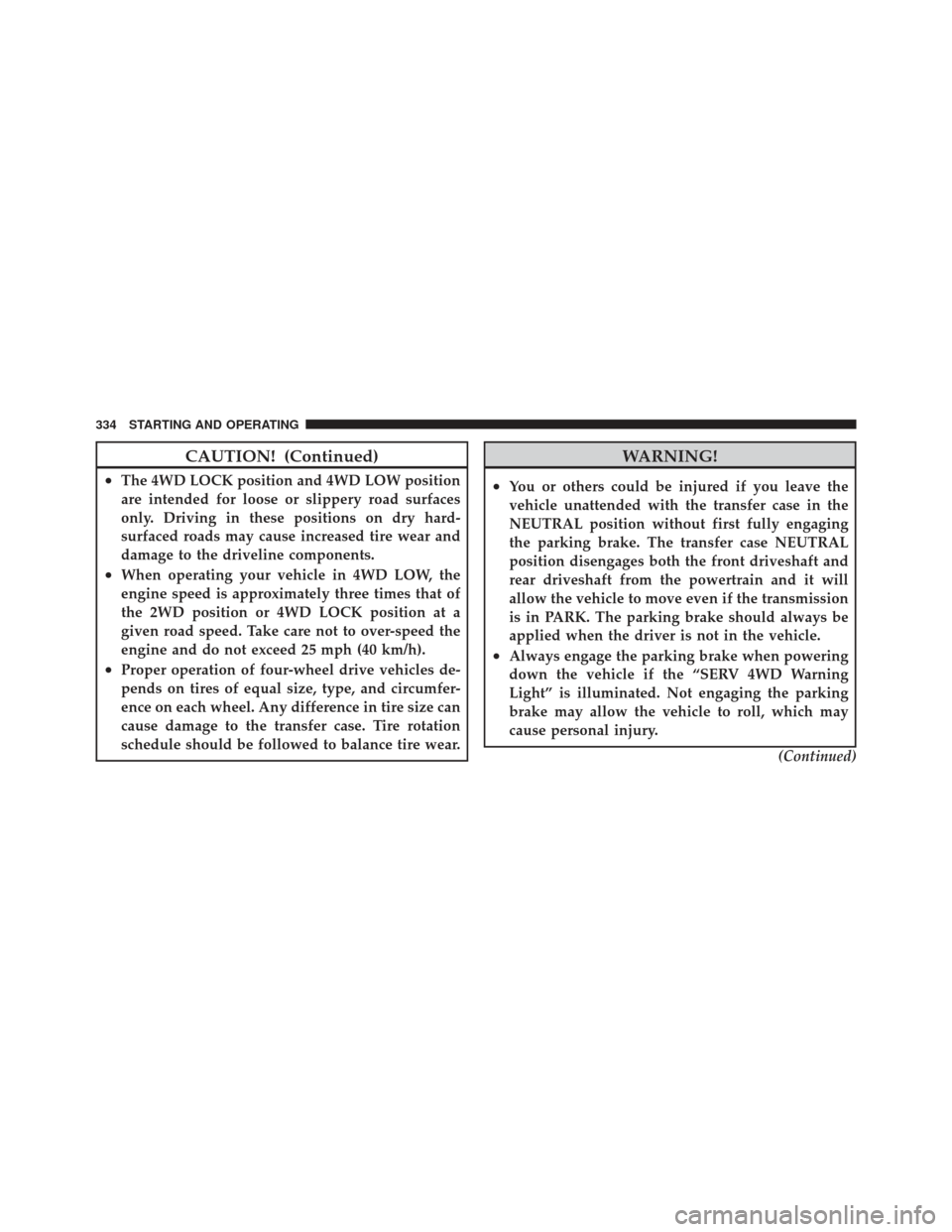
CAUTION! (Continued)
•The 4WD LOCK position and 4WD LOW position
are intended for loose or slippery road surfaces
only. Driving in these positions on dry hard-
surfaced roads may cause increased tire wear and
damage to the driveline components.
•When operating your vehicle in 4WD LOW, the
engine speed is approximately three times that of
the 2WD position or 4WD LOCK position at a
given road speed. Take care not to over-speed the
engine and do not exceed 25 mph (40 km/h).
•Proper operation of four-wheel drive vehicles de-
pends on tires of equal size, type, and circumfer-
ence on each wheel. Any difference in tire size can
cause damage to the transfer case. Tire rotation
schedule should be followed to balance tire wear.
WARNING!
•You or others could be injured if you leave the
vehicle unattended with the transfer case in the
NEUTRAL position without first fully engaging
the parking brake. The transfer case NEUTRAL
position disengages both the front driveshaft and
rear driveshaft from the powertrain and it will
allow the vehicle to move even if the transmission
is in PARK. The parking brake should always be
applied when the driver is not in the vehicle.
•Always engage the parking brake when powering
down the vehicle if the “SERV 4WD Warning
Light” is illuminated. Not engaging the parking
brake may allow the vehicle to roll, which may
cause personal injury.(Continued)
334 STARTING AND OPERATING